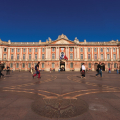CAPITOL
Without doubt the most famous city hall in France. With its square and its cafés, its Salle des Illustres, its Croix du Languedoc, its opera.
The Capitole is the heart of the city of Toulouse, both the seat of political power - it has served as the city hall since its construction in 1190 - and the home of the Toulouse Opera. The history of the building dates back to the end of the 12th century when the first chapter of consuls of the city - called the capitouls - chose this location far from the castle and astride the rampart that separated the merchant city from the town of Saint-Sernin. They acquired land to house the administrative services, the archives, the prison, the meeting and reception rooms (Grand and Petit Consistoire). Century after century, they enlarged the common house until it looked like a palace.
TheCapitol dungeon , a former archive and powder tower, hence its defensive aspect with watchtowers and machicolations, housed the Petit Consistoire on the first floor, and since 1948, the reception desk of the Toulouse tourist office. The construction dates from 1525-1526. The belfry look with its astonishing slate roof is due to Viollet-le-Duc who restored it between 1873 and 1875.
The Henri IV courtyard, surrounded by arcades (1602-1607), is decorated with a Renaissance portal by Nicolas Bachelier (1546), surmounted by a marble sculpture representing the King of France. One can see the different coats of arms of the families of the capitouls. A plaque on the floor recalls the decollation of the Duke of Montmorency on October 30, 1632.
The reception rooms. The monumental staircase decorated with a painting by Jean-Paul Laurens illustrating the First Tournament of the Floral Games, May 3, 1324, leads to the reception rooms. The first room on the first floor, known as the Paul Gervais room, was used as a wedding hall. The cycle of paintings illustrates the Allegories of Love at twenty, forty and sixty and the idyllic Island of Cythera where Aphrodite lived. The second room is decorated with ten paintings by Henri Martin. They represent on one side The Banks of the Garonne (where members of his family and friends, including Jean Jaurès, are portrayed) and on the other The Four Seasons. Finally, the Salle des Illustres is a long gallery, 68 m long, open on the main façade, decorated with busts of famous people from local history. At each end are two paintings, The Siege of Toulouse by Simon de Montfort in 1218 by Jean-Paul Laurens and The Arrival in Toulouse of Pope Urban II by Benjamin Constant. The architect Pujol was greatly inspired by the Farnese Gallery in Rome. It is now used as a reception and wedding hall.
The facade is 168 m long. In neoclassical style (1750-1760), it alternates brick and stone. The 8 pink marble columns represent the 8 capitouls who ruled the city on the eve of the French Revolution. Their coats of arms can be found on the balconies. The right part of the building is dedicated to the Toulouse Opera.
The 12,000m2 square is used for political, cultural and sporting events. In its center, the Languedoc cross, also called Occitan cross, is the work of Raymond Moretti (1997). Unfinished project of a royal square, it was not until the 19th century that the whole was completed with brick buildings designed by the architect Virebent and occupied by large cafés such as Le Bibent or Le Florida. Under the arcades, 29 silkscreens by Moretti tell the great moments of local history.
Did you know? This review was written by our professional authors.
Members' reviews on CAPITOL
The ratings and reviews below reflect the subjective opinions of members and not the opinion of The Little Witty.












ma taxe foncière a augmenté
La place est spectaculaire mais la bonne surprise reste la possibilité de visiter gratuitement le Capitole.
Mi-hôtel de ville, mi-musée, on déambule librement en découvrant à la fois les salles du conseil et des cérémonies et les oeuvres des artistes locaux (Paul Gervais, Henri Martin, etc.). Une belle combinaison !